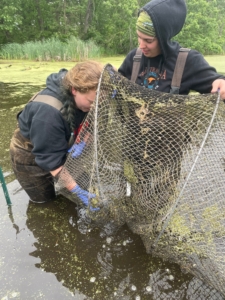
Alexis removing a frog from the trap while Maura holds the trap above water
Welcome back readers! Full disclosure, we wrote this blog about 4 weeks ago and forgot to ever publish it. So, now we get a walk down memory lane while Maura and Alexis are working our way through all of the lab work from the field. For those that have read one or more of our blogs, you may have noticed we have three main ways to find turtles out here in the marshes.
First and most common is trapping. Positives to this method is that we catch a variety of species (Blanding’s, Sanppers, and Painteds) and is often how we find new turtles for the county. The main negative is that there is no predicting what we find, sometimes we are super successful and other times we go an entire week with nothing popping up in a trap and we are left to wonder if we could have placed it in a better position.
Another method is visual surveillance, also known as hand-caps. Readers of last years blog may remember Alexis having 2 (both being painteds), and Maura found one painted this season. This method has a very low effort-to-success ratio and is generally never our sole method in Kane County. The only rule for this capture method is “see the turtle, grab the turtle.”
The third and final method is radiotelemetry and is reserved for only the Blanding’s turtles. Turtles are fitted with a radio transmitter on their shell which emits a radio signal. We carry a receiver and antenna that are able to pick up that signal, relayed as beeps that grow louder as you get closer to their proximity. Blanding’s turtle radiotelemetry often means walking through sticky bottom marshes, digging in mud, and playing a game of “bird or beep?” If given the right amount of patience telemetry has nearly a 100% success rate and sounds like most effect method, but telemetry has lead to quite a few tails this summer.
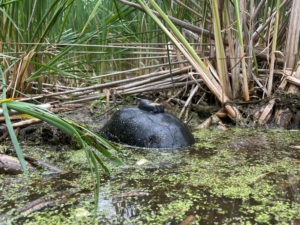
Transmitter visible on the top of this male’s shell
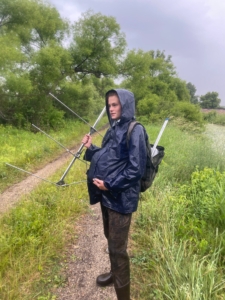
Natalie keeping the receiver safe in the rain
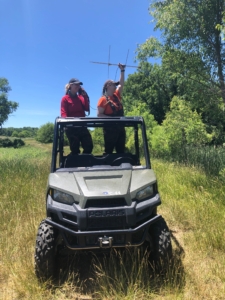 It all started with day three of the season when Natalie, Maura, and Alexis set off to find one of the females. It was the end of the day and we had a little bit of a time crunch. We ended up on a tough terrain route, no breaks, and a long trek that left Maura a little concerned for what was to come this season (she still prefers traps to telemetry these days). A few weeks later, Alexis ended up on a trek literally across the length of our largest site in search of one of last year’s headstarts. When finally finding the turtle, she was so far from the entrance she ended up calling Maura and Natalie to drive around the forest preserve to rescue her. A similar experience happened to Natalie just the next week. On the opposite end of the spectrum, sometimes the turtles are so close but difficult to capture. Just last week, one female was found in the middle of a a pond where Alexis and Natalie ended up circling in a 10 foot radius for 5 minutes and the turtle continued to swim around them (Maura, Bill, and Joey watched entertained from the side as they worked up another turtle).
It all started with day three of the season when Natalie, Maura, and Alexis set off to find one of the females. It was the end of the day and we had a little bit of a time crunch. We ended up on a tough terrain route, no breaks, and a long trek that left Maura a little concerned for what was to come this season (she still prefers traps to telemetry these days). A few weeks later, Alexis ended up on a trek literally across the length of our largest site in search of one of last year’s headstarts. When finally finding the turtle, she was so far from the entrance she ended up calling Maura and Natalie to drive around the forest preserve to rescue her. A similar experience happened to Natalie just the next week. On the opposite end of the spectrum, sometimes the turtles are so close but difficult to capture. Just last week, one female was found in the middle of a a pond where Alexis and Natalie ended up circling in a 10 foot radius for 5 minutes and the turtle continued to swim around them (Maura, Bill, and Joey watched entertained from the side as they worked up another turtle).
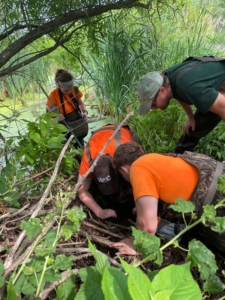
Beaver den exploration
But all of these tails pale in comparison to one particularly tricky female that chose to hide in a beaver dam. After using the receiver to discover she was literally under our feet in an abandoned beaver dam, we could have aborted mission but Alexis was determined to sample this girl and began digging at the ground. After the initial laughs, Joey and Bill joined in while Maura and Natalie continued to “supervise” and periodically check the receiver to make sure she was still under us. After roughly 10 minutes of digging, blind reaching, and teamwork we were able to safely extract the female. And don’t worry readers we took the time to reconcile the ground entrance once returning her to the den. In the words of Bill, “If anyone can do it, it is all of us together!”
